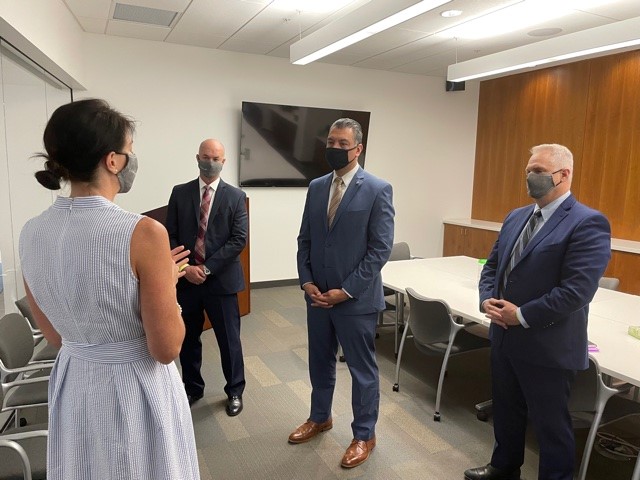< Back to blog
Sen. Alex Padilla Visits ISO, Briefed on Summer Readiness
June 2021
 U.S. Sen. Alex Padilla came back to California June 1 to draw attention to infrastructure negotiations in Washington and stopped by the ISO for a brief tour and update on the electric grid’s readiness for hot summer weather.
U.S. Sen. Alex Padilla came back to California June 1 to draw attention to infrastructure negotiations in Washington and stopped by the ISO for a brief tour and update on the electric grid’s readiness for hot summer weather.
“The California ISO is truly the nerve center for California’s power grid, overseeing 80 percent of the state’s electricity,” Padilla told reporters outside ISO headquarters in Folsom.
“The tens of thousands of transactions that are conducted each and every day enable the business community to thrive and for all of us to go about our daily lives. But, unfortunately climate change is continuing to increase the frequency and the severity of disasters around the country, and extreme weather events around the country, events that endanger the power supply to our homes, to our schools, to our businesses, to our hospitals and more.”
The Democratic Senator from Los Angeles was also promoting his own legislation that calls for a federal investment of $400 million over four years to fund grid resiliency projects around the country.
“Securing the resiliency of the California grid is important,” Padilla said after getting an overview of the ISO’s control center, where ISO operators assess and manage the grid 24 hours a day, 365 days a year. “And given the season we’re in, we must be very cognizant to what it means for wildfire safety.”
Strengthening the grid in California and around the nation, Padilla added, can also enable businesses to more quickly transition to clean energy.
In addition to members of his staff, Padilla was joined by several ISO executives, including Mark Rothleder, senior vice president and chief operating officer.
After the tour, reporters asked both men whether California can expect more power outages like those the ISO had to employ last August during a record-setting heat wave that hit the entire Western United States.
With extra capacity, market enhancements and improved communications protocols and weather forecasting, Rothleder said the ISO is “guardedly optimistic” about the grid’s performance this summer.
“We’re very confident that with conservation when we call upon it through Flex Alerts, advanced communications (and) additional resources . . . that we’ll be able to manage this without having to resort to rotating blackouts or anything like that. But, again, the risk is there.”
By the hot summer months of August and September, California will have about 3500 megawatts of additional capacity available for the grid. About 2000 megawatts—enough to power about 2.6 million homes—will be from new battery storage required by the California Public Utilities Commission.
“So we’re taking steps to not only utilize the existing infrastructure . . . but also to ensure over the longer term that we also have sufficient infrastructure for the right period of time when we need it,” Rothleder noted.
Since lithium-ion batteries can provide electricity for about four hours before needing to be recharged, the additional battery capacity is expected to help the grid operate during crucial summer hours when demand peaks in hot weather, the sun is setting and some 10,000 megawatts of solar energy is no longer available.
If the new battery power had been available, charged and used during those crucial evening hours last August, Rothleder explained, it’s very likely the outages could have been avoided.
He also touched on how the ISO is being more pro-active in talking about possible stress on the grid in communicating with the general public, government agencies, industry and utilities so they can help avert a possible emergency through voluntary conservation.
“This past weekend,” he pointed out, “even though there wasn’t an extreme event, we did communicate that we were monitoring the situation, temperatures were higher, loads were higher and we had enough resources.”
Had conditions deteriorated, he said, the ISO would have issued more bulletins or a Flex Alert asking consumers to cut back electricity use from 4 p.m. to 9 p.m.
As he told Sen. Padilla while looking over and into the ISO control room before the press conference, “The last few days were a preview, but it was a good preview.”
< Back to blog